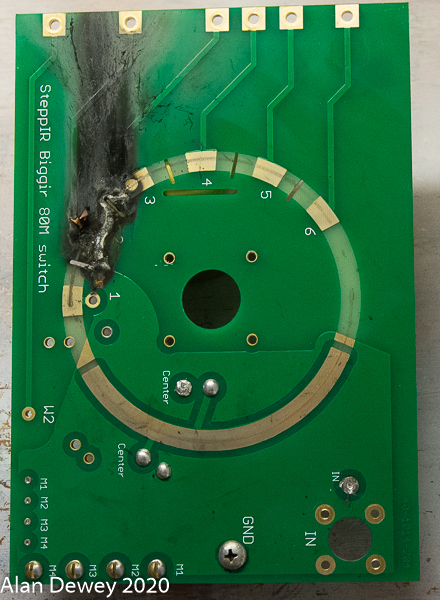80 meter problem is NOT Steppir’s fault!
At the beginning of February my Steppir Biggir with 80m coil kit failed again.
That was the bad news.
The good news is that we can learn from failure. I now believe that I know exactly what has caused these failures. It is NOT the manufacturer’s fault !
If you are interested in what I went through last year, start with this article “Repairing-a-steppir-biggir-vertical”
So, what caused all this grief ?
I believe it is due to VHF parasitics in my ‘new’ amplifier.
I do not yet have conclusive evidence, but VHF parasitic oscillations explains everything.
- I reviewed my logs and I had no trouble before I switched to the ‘new’ amplifier
- My previous amplifier was a Heathkit SB-1000 that I built in 1988. In the late 90’s I added Richard Measures parasitic oscillation prevention kit. That amplifier never spit or arc’d again over the next 20 years that I used it. Output was usually 700 W CW.
Though Mr. Measures has passed away, many versions of the Suppressor Retrofit Kits are still available. I will be installing the kit for my two 3CX800A7 amp very soon. - The “new” amplifier will do 1,500 watt on CW. When operating properly, that is only 41% more voltage and 41% more current going to the antenna.
- I have not been able to find that anyone else has had identical or near-identical problems. If you have, please leave a comment below.
- My last modificiations to the 80m switch pcb was to remove tap 2 (first coil tap) and use a Dremel router to increase the creepage distance This last arc event required a little over 55mm creepage path over the switch pcb. According to the calculator at https://www.smps.us/pcbtracespacing.html 55 mm is recommended creepage for 11,000 V peak. That would be 22,000 Vp-p which is 7,800 V rms.
- Even a ‘small’ and ‘brief’ parasitic oscillation can produce extremely high voltages in the 80m coil, and therefore, on the antenna. Example, if there is an oscillation at ‘only’ 80 MHz the impedance of the coil at the frequency is 20 x greater than it is at 4 MHz. If the parasitic oscillation happens to be at, or near, one of the self-resonant frequencies of the 80m loading coil, the net impedance may be hundreds of times higher
GOOD NEWS is that the EHU has no indications of degradation from this last arcing event. So I conclude that my changes to the EHU mount have provided a huge improvement in the amount of voltage it can withstand.
I do not yet have conclusive evidence of parasitic oscillation in this amplifier. I did perform almost all of the tests suggested here: https://www.w8ji.com/testing_for_stability.htm and have not had any indication of oscillation yet.
Also note that there were periods of months that the antenna operated and suffered no damage. So if it is VHF parasitic oscillation, it is very infrequent.
My short term solution was to re-install my Nye Viking MBV-A matchbox in the line. From now on, whenever I am on 80 or 75, I will run the signal through the matchbox. When tuned for 80m 50 ohm source to 50 ohm load it has very little loss and at higher HF frequencies on up it has great attenuation, varying from 30 dB to 60 dB across the spectrum. That should at least prevent VHF signal from getting to the Steppir antenna system.
Because I had the antenna “down” (removed from its mounting post) I figured I would disassemble it quite a bit to inspect everything to see how it has been “aging.” This would also be a good time for any preventive maintenance. Looking on the internet for ideas, I found this interesting article by W4GKF.
W4GKF has developed a system that regularly, automatically, cleans the Steppir elements to ensure good contact from the feed ‘brushes’ to the copper tape. His technology can not be used on the vertical, but those of you with dipoles, beams, etc from Steppir may want to consider it.
You might think his solution is pricey, but heck, you already bought an expensive antenna because of the convenience and performance advantages. So I think W4GKF’s solution is priced well for the convenience it provides. Click this link to read about it.
If you are interested in the saga of troubleshooting and repair, here are links to “the rest of the story.”
- Repairing a Steppir Biggir Vertical – part 6 – Rebuilding the EHU again – the final fix 🙂
- Repairing a Steppir Biggir Vertical – part 5 – Rebuilding the EHU
- Repairing a Steppir Biggir Vertical – part 4 – The Failure Point
- Repairing a Steppir Biggir Vertical – part 3 – Chasing My Tail
- Repairing a Steppir Biggir Vertical – part 2 – rebuilding the 80 meter coil assembly
- Repairing a Steppir Biggir Vertical – part 1 – Diagnosing the Failure



Hello, Looks like I have a broken motor sprocket shaft on my BigIR, sounds fairly common, is there anyone making a metal version of these or a stronger version?
A metal sprocket shaft might be a good idea. I have not looked closely at it, but would there still be sufficient insulating distance from the sprocket to the motor?